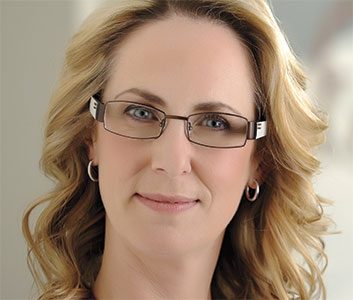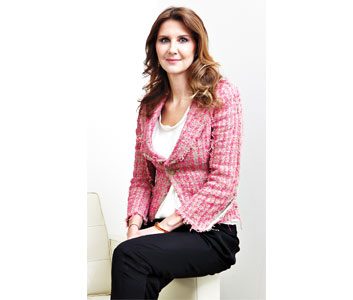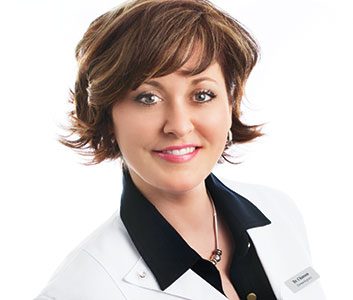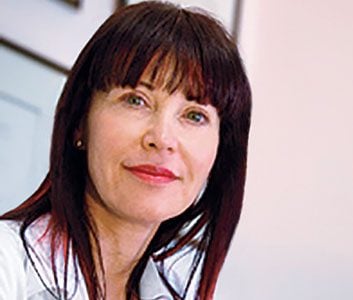
Dr. Gabriele Weichert, Nanaimo, B.C.
An ability to merge science with a people-oriented profession is why medicine appealed to Gabriele Weichert, 46, who is originally from Ottawa. She initially considered becoming an art history major, but says dermatology appeals to her “visual brain.” Weichert established her clinic, Skin Care West, in Nanaimo, B.C., where she lives with her husband and two children. In the summer, she enjoys running, mountain biking, kayaking, paddle-boarding and hiking.
Her sun-protection advice: “I’ve seen people who have significant sun damage, but when they adopt a really strict sun-protective habit, damage doesn’t compound over the years. So it’s never too late to be careful.
“What I see in my patients more than anything is that most people do use sunscreen-but only ‘kind of.’ They really under-apply it. To truly get the full SPF protection that’s stated on the bottle, it has to go on so heavy that your skin looks ridiculously white. Then rub it in.
“If I’m out and about, I wear SPF 60 and a wide-brimmed hat. I’m also a big advocate of sun-protective clothing. And if I’m at the beach with my family, I almost always have either a towel or a sarong to throw over my legs and shoulders. I’m a pretty outdoorsy person, but I can’t be out in the midday sun without feeling like I’m way too exposed, so generally I try to schedule most of my family’s outdoor activities for the late afternoon.”
Her product advice: “Neutrogena and Ombrelle, the Anthelios line from La Roche-Posay-these are all strong leaders in the sunscreen market. And they have products for the face that are thin, easy to put on, not sticky, not acne causing, that feel like a moisturizer and give you great protection.
“Also, SkinCeuticals has an antioxidant serum called CE Ferulic, which I layer sunscreen on top of. It enhances the ability of the sunscreen to protect your skin.”

Dr. Sandy Skotnicki, Toronto
The diversity of dermatology appealed to Sandy Skotnicki. She began practising in the Toronto area in 1997, and founded the Bay Dermatology Centre in 2006. Born and raised in Oshawa, Ont., the mom of three sons (who gives her age only as “over 45”) stays active in the summer by running, sailing, mountain biking and hiking.
Her sun-protection advice: “As a dermatologist, you’re a little more paranoid-after all, I see people die from skin cancer. But I’m human, and sometimes I forget to be careful, although I’m more worried about my kids. I always say to my patients it’s okay to be outside and it’s okay to get some sun, but you have to be sun smart.
“When I’m planning an activity, I try to do it before 11 a.m. or after 3 p.m. when the sun isn’t at its strongest. If the UV index is really high, you might want to do your outdoor activity on a different day altogether. I always wear a hat, sunglasses and sunscreen, which I’ll reapply if I’m swimming or sweating. When possible, I seek shade. For people who work outside or can’t avoid the midday sun, I recommend sun-protective clothing. Whether golfing or gardening, put on a long-sleeved shirt, a hat and sunscreen-don’t forget your décolleté-and you’re good to go.”
Her product advice: “I look at the science and the efficacy of the ingredients used by various companies, and the brands I recommend are Neutrogena, La Roche-Posay, Ombrelle and Vichy. I also like SkinCeuticals Physical Fusion UV Defence SPF 50 for the face.
“I always have sunscreen in my purse and in my car. But it can degrade in the heat, so you want to keep it in a cool place if that’s possible. Another tip: If the expiry date has passed, throw it out.”

Dr. Chantal Chiasson, Shediac, N.B.
A family friend who was a physician encouraged Chantal Chiasson to pursue a career in medicine. Dermatology appealed to her, and she now has her own clinic, the Figurra Institute, in Shediac, N.B., where she lives with her partner. Born and raised in New Brunswick, Chiasson, who is in her 40s, loves yoga, spinning and running-she’s completed a few half-marathons.
Her sun-protection advice: “When I was young, I didn’t listen to my parents and the lessons about skin cancer and sun damage, and I tried to get a tan. But now I know we should be protecting our skin as soon as we can, and that’s an important anti-aging element. I stay in the shade and wear a broad-brimmed hat when gardening and walking. I also wear sunglasses, because the eyes can get damaged with cumulative sun exposure.”
Her product advice: “Year-round, I use a moisturizer with SPF, Pro-Derm Daytime Fluid SPF 20. This is important because UVA rays can penetrate through clouds and car windows, and not only in summer. For my body, I like Elta sunscreens like Sport SPF 50. Avène High Protection Mineral Cream SPF 50 is good for people whose skin easily pigments with sun exposure. Don’t forget after-sun skin care. You can reduce and even reverse, to a point, the effects of UV damage by using a good vitamin C cream or serum with more than 5% L-ascorbic acid to help fight free radicals. I use Vivier CE Peptides, typically at night.”

Dr. Andrée Mathieu-Serra, Montreal
Andrée Mathieu-Serra opened her own clinic specializing in cosmetic dermatology after having worked as a dermatologist at a Montreal hospital for more than 20 years. She chose dermatology because she likes how “we see the disease, and the results after treatment.” Born and raised in Montreal, Mathieu-Serra, 63, is married and has three daughters. In summer, she likes cycling, golfing and gardening.
Her sun-protection advice: “When I was a student, I worked outside all day long in the sun without any sun protection. At that time, having a tan was considered healthy-looking. Now we know that the sun is the most important external factor that ages our skin, and we are seeing more and more skin cancer. Pre-cancer cells are showing up around the age of 40 to 60, depending on the person’s past exposure. I try to garden in the morning or evening. For me, the right clothes are essential. I always wear a large hat and big sunglasses that wrap around the sides. And I wear long pants and long sleeves when cycling, too, even if it’s a hot day.”
Her product advice: “On mornings when I know I’ll be outdoors for a few hours, I put on a high-SPF sunscreen on the exposed parts of my body. I prefer Pro-Derm SPF 60 for my face and neck. I use a vitamin C serum first because it contains antioxidants, then I put on my sunscreen. After being in the sun-for example, if I’ve been at the beach-I use a moisturizer with peptides because it helps with skin repair.”
Related:
• 21 tricks for healthy skin
• What to expect from a UV skin-scanning facial
• 5 common sun protection mistakes
